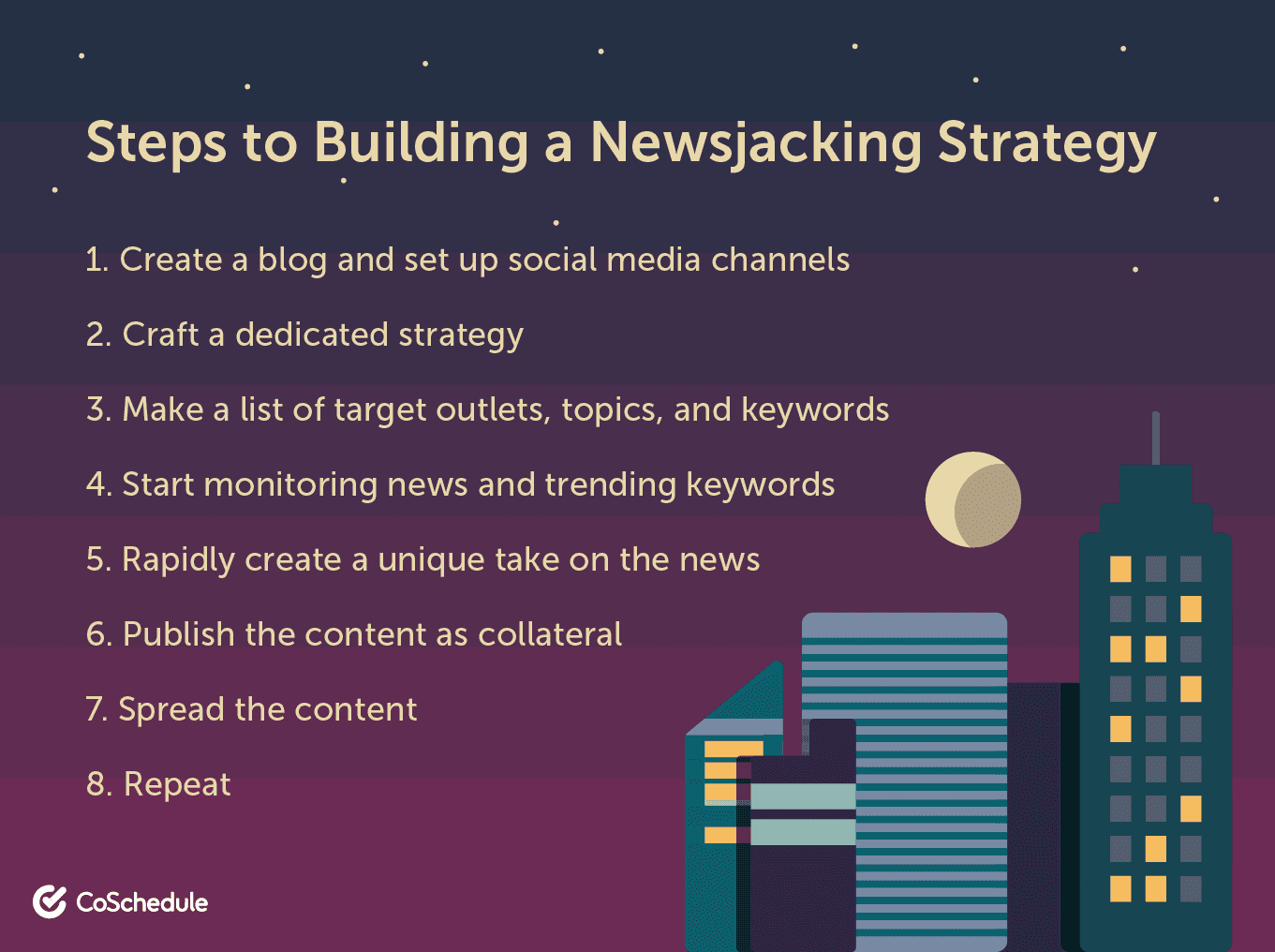The Complete Guide to Newsjacking: How to Grow Your Blog Traffic by Capitalizing on the News
 Newsjacking can be a valuable marketing tool to have in your arsenal. The best part about newsjacking is that it can be utilized by blogs, businesses, and social media channels of all sizes. You can use newsjacking to boost your brand’s recognition, engage with people on social media, and increase your revenue.
While the core principles of using the news to get your word out are relatively straightforward, creating a successful newsjacking campaign can take time, trial and error, and persistence. There are also several ways you can gain from the news — from delivering a humorous punchline based on some breaking news to becoming a source for the journalists as they scramble for information.
In this article, we’ll take an in-depth look into newsjacking, go through a step-by-step guide on how to capitalize on the news, and see successful cases in action. Furthermore, given that you need to create newsjacking content rapidly, you might get unwanted results. Therefore, we’re also looking at what you should avoid when creating content and sharing it with the world.
Let’s get started with the basics and then move deeper into the subject.
Newsjacking can be a valuable marketing tool to have in your arsenal. The best part about newsjacking is that it can be utilized by blogs, businesses, and social media channels of all sizes. You can use newsjacking to boost your brand’s recognition, engage with people on social media, and increase your revenue.
While the core principles of using the news to get your word out are relatively straightforward, creating a successful newsjacking campaign can take time, trial and error, and persistence. There are also several ways you can gain from the news — from delivering a humorous punchline based on some breaking news to becoming a source for the journalists as they scramble for information.
In this article, we’ll take an in-depth look into newsjacking, go through a step-by-step guide on how to capitalize on the news, and see successful cases in action. Furthermore, given that you need to create newsjacking content rapidly, you might get unwanted results. Therefore, we’re also looking at what you should avoid when creating content and sharing it with the world.
Let’s get started with the basics and then move deeper into the subject.
The Complete Guide to Newsjacking: How to Grow Your Blog Traffic by Capitalizing on the News
Click To TweetBut First, Claim Your Editorial Calendar Template
The goal of newsjacking is to increase traffic to your blog or website, but that is useless if you aren't already planning and executing a content strategy. Set your marketing efforts up for success with this editorial calendar template made by marketers, for marketers.What is Newsjacking?
Newsjacking is a marketing technique that leverages relevant trending news to spread a message or a brand. The timing for this strategy takes place after breaking news comes out and before journalists scramble for information. Newsjacking
The core of a successful newsjacking is speed because news has a relatively short life span, and you’re also competing against other people attempting to gain exposure.
You can choose multiple angles on how to go about pitching in on the unraveling story:
Newsjacking
The core of a successful newsjacking is speed because news has a relatively short life span, and you’re also competing against other people attempting to gain exposure.
You can choose multiple angles on how to go about pitching in on the unraveling story:
- Be creative
- Deliver humor
- Use data
- Share expertise
 The most critical underlining aspect of a successful newsjacking is that your pitched idea or comment is relevant and original; therefore, it has to be creative.
The most critical underlining aspect of a successful newsjacking is that your pitched idea or comment is relevant and original; therefore, it has to be creative.
Perks of Successful Newsjacking
Even though the newsjacking content isn’t generally evergreen and there’s a high chance of coming out as insensitive, there are considerable upsides. A well-thought newsjacking campaign can dramatically affect the success of your business. However, don’t expect things to turn around for your business overnight. Most newsjacking campaigns take time to become successful and largely depend on your timing and effort. When creating your content on top of the news, you can leverage multiple channels to spread your message. You can create your newsjacking campaign targeting official news agencies or spreading your take around on social media. Whichever strategy you choose, there are various perks. However, combining your outreach increases your chances of getting picked up by journalists or having your message become viral. Let’s look at the main upsides that you can expect from a successful newsjacking effort.
1. Links or Citations From Significant Publications
When breaking news emerges, journalists start to look for more information to create a story. While it may seem that the gist of some urgent news is coming out as a few lines of text, the story expands afterward. This is where journalists start to gather additional information to create unique content for their readers and look for supplementary angles built on the story. Since the news needs to be fresh, they often turn to social media and search engines for material, and this is where you can step in to give them what they want. If you can create a timely, valuable piece of content, you have a chance of getting a citation from major publications looking for that additional information. That’s not a small matter either — as millions of people read popular publications. However, since the media mostly looks for credible information, your creative or humorous angles might not gain journalists’ attention, but your expertise and data certainly can.2. Increased Reach and Organic Traffic
Even if your content doesn’t reach major publications, you can still expect an increased reach and higher organic traffic — depending on the channels you use. Let’s consider social media channels where you can post your content directly or share a link to your blog post. Unmetric’s study shows that successful newsjacking on Twitter receives an average of 0.7% increase in followers. While a positive newsjacking result brought in between 500–11,500 new followers, a negative attempt resulted in around 80–2,300 subscribers. While this might not seem a lot at first, it can quickly build up as you create more content on top of news and share it across the platforms. Unmetric
You should also consider that not every newsjacking attempt will become a successful one, and there’s a lot of trial and error involved. However, if you’re looking for more attention and traffic, the perks of a successful newsjacking are definitely worth the work.
Unmetric
You should also consider that not every newsjacking attempt will become a successful one, and there’s a lot of trial and error involved. However, if you’re looking for more attention and traffic, the perks of a successful newsjacking are definitely worth the work.
3. Brand Recognition and Authority
A successful newsjacking effort (or multiple ones) gives you the opportunity of becoming a thought-leader in your segment. A data-based or authoritative article picked up by major publications or shared on social media creates a point of leverage that you can use when creating additional content on your blog. When significant publications pick up your content, or you’ve contributed to the conversation, people naturally start to expect your contribution and recognize it. While it might be slow to start, it builds up quickly over time, since you can leverage the successful content to build more recent content on top of the success.
4. It’s Free
While you can pay digital media agencies to build content that’s worthy of a newsjacking effort, you can also leverage newsjacking on a shoestring budget. The primary resources newsjacking needs are time and attention. We’re shortly looking at the components that make up the process, but most of it consists of being mindful of trends, news, and quickly creating relevant content. While a large corporation with a huge marketing team has an edge in producing content quickly or even ahead of time (speculating the trending news), you can achieve the same results by yourself or with a smaller team. The central aspect to consider is that known brands already have a large following and authority, so it’s a bit easier for them to break through the ceiling. However, the beauty of newsjacking is that the ceiling is breakable — even by unfamiliar brands and blogs — by being in the right place at the right time, and you can do so, free, by investing your time into the process.Getting Started With Building a Newsjacking Strategy
 News is produced by the media 24/7, and you only have a small window of opportunity to leverage breaking news to further your success. Therefore, speed is the utmost important factor in creating a successful newsjacking effort.
News is produced by the media 24/7, and you only have a small window of opportunity to leverage breaking news to further your success. Therefore, speed is the utmost important factor in creating a successful newsjacking effort.
Speed is the utmost important factor in creating a successful newsjacking effort.
Click To Tweet1. Create a Blog and Set Up Social Media Channels
First, you need a target medium where you create and publish content to target breaking news and where you want the attention directed. Setting up a blog is relatively straightforward; it can be a part of your business website, eCommerce site, or a stand-alone blog. While there are free blogging services, it’s better to self-host a blog as you have no limitations with content, you can freely customize it, and at the end of the day, you reserve full rights to it. Next, set up social media accounts you can use later to spread your created collateral for increased reach. Since 88% of companies are using social media for marketing, it is a powerful tool for distributing your content. You can use these channels as a gateway to share the original article and reach the targeted audience. If setting up a social campaign is new to you, use CoSchedule’s best practice for inspiration. You can, of course, personalize this calendar based on your brand’s social channels. While creating accounts on these platforms is reasonably easy, picking the right ones to match your industry can be a bit trickier and require some trial and error.
When considering the reach of potentially newsworthy material, some social media channels perform better than others. For example, Twitter is generally considered a hub for trending and breaking news because of its unique platform built upon speediness.
Sure, you won’t have many followers at first, but this shouldn’t stop you from creating content and utilizing the newsjacking effect. After all, one of the main perks of a successful newsjacking is increased following and reach.
While creating accounts on these platforms is reasonably easy, picking the right ones to match your industry can be a bit trickier and require some trial and error.
When considering the reach of potentially newsworthy material, some social media channels perform better than others. For example, Twitter is generally considered a hub for trending and breaking news because of its unique platform built upon speediness.
Sure, you won’t have many followers at first, but this shouldn’t stop you from creating content and utilizing the newsjacking effect. After all, one of the main perks of a successful newsjacking is increased following and reach.
2. Create a Dedicated Strategy
Newsjacking is all about speed and getting your content out before anybody else has had a chance to react. Being there first creates a considerable benefit as the trending topic becomes more relevant. You can increase your efficiency and get your side of the story out by creating a workflow strategy that you can easily follow once a trending topic becomes relevant for you to capitalize on. The most straightforward way is using a work management tool, such as CoSchedule, to simplify your workflow and easily outsource specific items to your colleagues. Since speed is one of the cornerstones of a successful newsjacking, clarifying what to do saves you valuable time. Depending on the content you’re about to create for the piece of news, some of the steps include: producing an article, creating visuals, proofreading the written content, posting and sharing them on chosen mediums, and following up with the audience. Create the workflow with efficiency in mind, so you have a chance to generate valuable content as fast as possible to capitalize on this effect. CoSchedule
CoSchedule
3. Create a List of Target Outlets, Topics, and Keywords
After you have your content creation process down, it’s time to do some research. You should create three lists for this purpose:- Target publications
- Relevant topics
- Target keywords
Target Publications
These are the news networks, sites, channels whose attention you want to attract. The people behind them can be journalists, experts, social media influencers, or other people who can use your take to bolster their own story. Having a list of targets makes it easier for you to spread your content and reach out to appropriate people. You can do so by tagging them in your social media posts, sending source information as tips, or reaching out to them in person. The critical aspect is that you won’t start to look for engagement possibilities while creating a story because that takes away valuable time and prolongs the publishing time.Relevant Topics
There isn’t always something groundbreaking happening every day. To create a more efficient newsjacking strategy and increase your options, you should create a list of topics in which you’re aiming to create content and stay relevant to your current medium. For example, suppose you have a blog about cars. In that case, you can leverage topics such as new technologies in the automobile industry, political policies related to car-created pollution, traffic safety research, and so on. The most crucial element here is that the topics you choose are relevant to your blog, website, and channel. Looking for newsjacking opportunities in the gardening topic with your blog about cars isn’t suitable. Also, creating content to leverage these topics is a far-fetched effort as well. While monitoring a broad spectrum of subjects increases your chance of stumbling on breaking news more often, writing content that’s irrelevant to your medium isn’t helping anybody.Target Keywords
The final list includes target keywords which you’ll use for the next step. These are relevant keywords that help you identify topics and news that you can then leverage. Think about these keywords as signals that you can set up that alert you immediately when a newsjacking opportunity arises. Google Keyword Planner is an excellent place to start looking for possible keywords relevant to your blog or business. Use this tool to zone in on your primary target keywords and generate ideas for connecting ones you can leverage for your newsjacking attempts.
Google Keyword Planner is an excellent place to start looking for possible keywords relevant to your blog or business. Use this tool to zone in on your primary target keywords and generate ideas for connecting ones you can leverage for your newsjacking attempts.
4. Start Monitoring News and Trending Keywords
To jump on the opportunity of creating newsjacking-worthy content, you should continuously be up to date with what’s going on in the scope of the topics you’re aiming to write. Once you have your topics and keywords from the previous step, you can now use them to set up automated alerts. Furthermore, you can bookmark news outlets, subscribe to RSS feeds, and follow social media accounts centered on breaking news. To monitor news more effortlessly, use automated tools, such as Hootsuite and Google News. For a more advanced approach, you can set up customized alerts on websites using Google Alerts. Last but not least, you can keep an eye on Google Trends to get a hint about what search engine users are searching for the most at the given time. Google Trends
Google Trends
5. Rapidly Create a Unique Take on the News
Once you identify breaking news that you want to leverage, you need to start creating content quickly. Generally, newsjacking content isn’t long-winded articles that go deep into a specific topic. Depending on the goal, even a single sentence can do the trick when posted on social media or a few paragraphs posted on your company’s blog. However, keep in mind that your piece is easy to read, provides value, and uses SEO elements (i.e. a keyword in the title and body, links to sources, etc.). Your created content needs to be professional and, more importantly, contribute to the emerging news. Once you’ve finished creating the content, make sure to triple-check any facts, as false ones can quickly turn an opportunity into a content nightmare.6. Publish the Content as Collateral
Once you’re done with the content, upload it to the blog you’ve set up. This could be a blog article, social media post, case study, or a data set based on the content. Make sure it’s easily accessible and shareable for everyone. The content here acts as collateral because it consists of valuable information for journalists or presents a unique perspective. Make sure the content is easily accessible and shareable. It’s also best to remove all pop-ups and other interstitials that keep the readers from the content. Apart from these intrusive elements being accounted as negative aspects for search engines(with Google aiming to punish pages that use excessive interstitials), the overall user experience and the accessibility of information also suffers if people don’t get the content immediately. Google Search Central
Google Search Central
7. Spread the Content
Once you have your collateral uploaded, use the marketing channels available to you to share the content. Share the content with your email subscribers, post a link to your collateral on social media, and email targeted journalists — among other outreach methods. When using social media platforms, make sure you also include hashtags and categories to narrow your content’s topic. If done correctly, doing so increases your chance of your content being in front of interested parties as they look for additional information to build on the news. Remember, journalists also scour social media for supplementary angles and scoop to give their stories a unique take. However, stay away from overflowing your posts with hashtags. Furthermore, when trying to reach journalists, you can use platforms such as Help a Reporter Out and Source Bottle for broader reach. Listing your source on these platforms increases your chance to get picked up by minor or major publications. This course of action is also invaluable to your blog if you’re just starting up and haven’t gathered authority yet.
8. Repeat
Now that your content is out there, it’s generally out of your hands if it attracts a journalist’s interest or goes viral, but that doesn’t mean you should be done with the effort. Since there’s an element of luck involved with each newsjacking case, it’s best to increase your chances by repeating the steps until you’ve reached your goal. While the first few, ten, or even a hundred attempts might not go the length, the perks of creating a successful endeavor down the line are still worth it — considering the low investment requirement.Successful Newsjacking Cases
Like we discussed before, the beauty of newsjacking is that everybody can leverage this strategy. However, we won’t deny that brands with a vast following have a somewhat easier time utilizing this strategy, but it also comes with an increased sense of appropriation — in case things go sour, the damage to well-known brands is much more broad and influential. Now that you know the theory and the basic process behind newsjacking, let’s look at some real-life cases from well-known brands and off-beat companies.Oreo Cookie and Super Bowl
Remember when in the middle of the Super Bowl the lights went out? Oreo used this opportunity to post an image on Twitter with a nifty caption: “You can still dunk in the dark”. This particular effort capitalizes on the humor side of newsjacking — making it effortless for people to relate to it and share it among friends. It’s interesting to learn that this specific content was in the works and waiting for the right moment for over a year. Still, the image went viral and is one of the most well-known newsjacking cases. Twitter
Twitter
LEGO and Tesla’s Cybertruck
During the Cybertruck presentation, Tesla wanted to demonstrate the sturdiness of the truck’s window if they’d use a hammer on it. Unfortunately, the window shattered, and it opened a window (pun intended) of opportunity for LEGO to capitalize on it. They created a tweet poking fun at the shattered glass by recreating LEGO’s version of a Cybertruck — promising that it was shatter-proof. The result was a viral tweet that was interacted with over 100,000 times. The LEGO newsjacking Tesla’s Cybertruck is another classic example of a humorous twist in an attempt to increase reach. Twitter
Twitter
Norwegian Airlines and Brad Pitt
Following the news about Brad Pitt and Angeline Jolie’s break up, Norwegian Airlines decided to create a whole campaign around it — laying the perfect foundation for newsjacking. They lowered their airline fare to LA with a message that one of the most sought-after men was now single. This created a buzz all around various social media platforms. While the end goal wasn’t necessarily to increase their revenue from trips to LA, it sure was a successful attempt to spread their airline brand. Campaign
Campaign
MarketWatch and The Walking Dead
Not all newsjacking cases are built upon global news. You can find a large audience in other sectors that could propel your message into viral territory. Let’s take an example of how MarketWatch leveraged the popular series, The Walking Dead, to create an article around management skills. They found out that many fans criticized the main character’s leadership and decided to write up all the mistakes he made. They created that article and shared it among the show’s fans, who expressed the same thoughts. They found a unique audience and increased their reach because of clever perception. MarketWatch
MarketWatch
David Meeran Scott and Occupy Wall Street
Following the Occupy Wall Street protests, David Meerman Scott used the news to share his opinions from a marketing and PR perspective. He wrote an article making suggestions to the movement on several marketing aspects. He optimized his article using SEO principles and keywords to make sure the topic was clear for the reader. Since the subject was trending on social media at the time, he was able to pitch in with his article and increase his reach towards people interested in the movement.
While this example happened over a decade ago, it serves as an excellent example of using the trending news to share your expertise in a specific field.
He optimized his article using SEO principles and keywords to make sure the topic was clear for the reader. Since the subject was trending on social media at the time, he was able to pitch in with his article and increase his reach towards people interested in the movement.
While this example happened over a decade ago, it serves as an excellent example of using the trending news to share your expertise in a specific field.
Advanced Tips for Newsjacking
We’ve now looked at how you can set up your newsjacking process and a couple of examples to get your ideas flowing. Now, let’s look at a few advanced tips that you should consider when including the newsjacking marketing tool into your arsenal.Track the Engagement, Analyze, and Draw Conclusions
Newsjacking as a marketing strategy is mostly a numbers game. The more you put out content to utilize the news, the higher the chance of successful campaigns. Therefore, studying the performance of your articles and posts increases the likelihood of a viral message or a citation by a journalist. As we mentioned, using newsjacking content to engage with the audience is one part of the equation. You can go further by tracking the engagement altogether, analyzing the traffic your articles and messages generate, and using the results to conclude. It’s a given that some angles work better than others and finding the right one requires some trial and error. You can start by setting up Google Analytics to track your website and blog’s basic traffic statistics. You can also set up Amplitude, which focuses on monitoring user experience and behavior on your site. Using both tools together gives you an excellent insight into how your site is performing. Similar to tracking your site’s traffic, you can also monitor the success of your social media posts that you use to spread your message. If you’re using Hootsuite to keep track of news, you can use the same software for social media monitoring as well. Tweepsmap is another useful tool — especially if you’re using Twitter as your main platform for newsjacking efforts. It highlights popular hashtags and gives you insight to your followers, posts’ performance, and funnels your community-building actions. Tweepsmap
Tweepsmap
Prepare for Higher Traffic
Leaving aside the social media-focused newsjacking attempts, you need a website to upload your collateral. It can be a website’s blog, newsletter, or a stand-alone blog, but you need a server or a hosting service to run your site. The very goal of a successful newsjacking is to increase traffic to your site or a blog. This means that you should also prepare your server to handle increased traffic as it’s flooding in. To prepare yourself ahead of time, make sure your servers can take an increased load without making your site slow down, or worse, go offline. If you’re using a website hosting service, make sure that they’re reliable and fast. A study into web hosting companies found relatively significant differences between performance metrics such as uptime (99.99% vs. 99.46% during a year) and load speeds (on average 297ms vs. 7,331ms). Therefore, having your website offline or slow when traffic hits negate your newsjacking efforts. Depending on the hosting service you go with, there might be limitations to bandwidth, which means that there’s a limit to the number of visitors your site can handle. Whether you’re using your own server or a hosting service to run your website, make sure to cover all possible angles, so your site remains operational — even with the higher traffic.Engage With the Audience
Your audience is a driving force behind newsjacking content as they share, comment, or build upon your content. Your readers’ activities further increase the reach and effectiveness of newsjacking. Creating viral messages or spreading your unique take on an important matter also relies on social engagement. While people can naturally interact with your content, leveraging the additional opportunities to further engage with them goes a long way. Engaging with your audience is especially recommended when building your newsjacking campaign to increase brand recognition or authority. The additional attention allows you to remain in contact and produce new messages based on the original one.
Engaging with your audience is especially recommended when building your newsjacking campaign to increase brand recognition or authority. The additional attention allows you to remain in contact and produce new messages based on the original one.
Common Mistakes With Newsjacking
We’ve already touched on a couple aspects that you should avoid with newsjacking in this article; let’s dig a bit deeper and look at some actions that you should avoid when creating content around trending news.If Things Go Sour, Take Your Post Down
Newsjacking strategies require you to be quick on your feet, but that opens up a vulnerability of things going sour. While you need to be sensitive when creating your content and keeping all interested parties in mind, sometimes your message can touch a wrong subject or come off as insensitive. If that happens, it’s best to take your content offline, rather than try to remedy the situation, because it might do more harm than good in the long run. If your article, comment, or tweet creates unwanted controversy, the best course of action is to apologize, take it down, and focus on new content. Here’s an example of newsjacking gone wrong. Twitter
Twitter
Never Spam Journalists
While it’s tempting to send a bulk email to every journalist alive and do that multiple times a day, it isn’t enjoyable. It can also break your relationship with the journalist before it even begins. Doing so increases your chance of landing your future emails in a spam folder and ruins the opportunity of being picked up by major publications. Also, don’t expect a response. While it can be discouraging not to get a reply for weeks or even ever, the patience is worth it and even appreciated by the journalists. Remember, newsjacking is a numbers game, so instead of wasting time trying to reach numerous journalists, focus on creating new content and try again. The most important part is that you carefully choose the journalists you reach out to and keep the content relevant. Most journalists have a specific field they write about, so find out which news they mostly cover.Don’t Overdo It With Hashtags
You can use hashtags to categorize your article on various social media platforms. Users subscribed to particular keywords can then stumble onto your post, even if they aren’t subscribed to your account. Therefore, using hashtags or other forms of categorizing your messages is an effective way to expand your reach. However, we’ve all seen social media posts with walls of hashtags just below the fold. Overflowing your newsjacking efforts with irrelevant hashtags comes off as cheap and might not further your endeavors. Only include hashtags and categories that are most relevant to your story and the targets you want to achieve. Doing anything more jeopardizes your newsjacking efforts and can even negatively impact it. The Artichoke
The Artichoke


